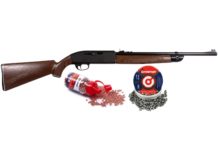Search Nature’s Restaurant & Wild Foods Home Garden Websites:
Season: Fall – October
Urban, Rural or Both: Rural Mainly
There are five kinds of Hickory Nut trees I am familiar with: The Big Shellbark Hickory (Carya laciniosa), the Shagbark Hickory (Carya ovata), the Bitternut Hickory (Carya cordiformis), and the Smoothbark (Pignut) Hickory (Carya glabra), and the Mockernut Hickory (Carya tomentosa). All you have to remember is the two you want to find for food are the Big Shellbark and the Shagbark. These two are very similar looking. One way to tell the difference between these two is the nut is larger with the Big Shellbark. In the winter when the leaves are gone, the Shagbark is a sparser and more raggedy looking tree than the Big Shellbark which is a beautiful tree in the winter. And the easiest way in the fall when out gathering is to look at the compound leaves. The Shagbark usually has five leaflets per leaf, while the Big Shellbark has seven. The Big Shellbark tends to like low lands areas – areas that occasionally flood near streams. The Shagbark likes uplands areas and does not like areas that flood. The Mockernut nut is also edible, but very small. The others have bitter nuts.
Hickory nuts are just incredible. The flavor is the best of any nut I’ve tried by far. Hickory Trees are in the Walnut (Juglans) tree family, and Pecans are a type of Hickory.
Shagbark Hickory nuts are what got me started in the world of wild foods. I’ve been collecting them since I was a child with my mother. Up until she was 13 years old, she lived on Indian Line right beside Ojibwe Road (the road names were different then), right beside Hagersville, Ontario. She would gather Hickory nuts from the Shagbark Hickory trees that grew along the side of Ojibwe Road. There are only two of that line of trees left on the west side of Ojibwe right near Indian Line that I gathered my first wild harvest from. Because Hickory nuts are so good, I started trying other wild foods thinking there must be other amazing flavors out there. Funny thing is, nothing else comes close. The first wild food I had was the best. Talk about beginners luck.
When I was a young teenager in the mid 1970’s, I had a mini-bike I used to ride in woods in Byron, Ontario. Every October I would take home backpacks full of Hickory nuts from a huge, mature Big Shellbark Hickory, and Shagbark Hickories that were in the area. Those trees are cut down, and it is all housing developments now. That huge, mature Big Shellbark would have been hundreds of years old.
To find, look for trees that the trunk is grey colored and the bark is quite shaggy in long vertical strips. The nuts of the good ones are easy to know from the ones you don’t want the good ones from the Shagbark and Big Shellbark have outer husks that are very thick and thick shells that are very hard to crack, while the bitter ones from the Smoothbark and Bitternut have thin, easy to crack shells and thin outer husks.
Don’t bother to look for them until late September to the end of October in my area. They are ready when the nuts start to turn from a leaf green color to a brownish color and the out husk splits open into four sections, and they start falling to the ground.
The husks are so thick and bulky, I find it is better to husk them while gathering, rather than take them home husk and nut. The husks fall off with very little effort. If the husk is on tight, don’t bother with that one, as in my experience, it means a worm has got into the nut.
One warning, if you collect at the right time, and it is breezy, be prepared to be whacked by the nuts falling from the tree they can hurt. A hat with a gap between the top of the hat and your head is not a bad idea. A wide rimmed straw hat is perfect.
You can eat them at harvest time, but they taste much better if you lay them out to dry in a dark, dry area. I find the basement near the furnace is best. By Christmas they are ready, and are good for years if stored properly. I have even had them quite edible after five years. They will attract mice and other rodents, so make sure wherever you set them out, these critters can’t get to them.
Cracking them open is an acquired skill, and my best advice is use either a vise, with the ends facing parallel with the jaws of the vice, and the thin side facing up and down, while the jaws of the vice are putting the squeeze on the wide sides. Make sure you are wearing glasses or safety glasses, as they can blow out sharp shrapnel when they do crack. That all said, the nuts of some trees do open better with the ends (top and bottom) in the jaws of the vice. You should experiment. I have never found it a good idea to put the pressure from the vice jaws on the narrow sides.
The other way is to hold the thin section with your finger and thumb, with one side on a cement floor and the other wide side facing up, and the ends parallel with the floor. Hit with a hammer, starting softer, then adding more strength as you hit until you hear it crack. At that point either keep lightly tapping with the hammer until it opens, or open with a nut cracker.
Recipe search on the web here (Google search) and here (Bing search).
Growing this plant in your home garden:
For detailed growing instructions, go to my Wild Foods Home Garden website Hickory Nuts page.
Shagbark Hickory (Carya ovata). There are two varieties, the Northern Shagbark Hickory (Carya ovata var. ovata) and the Southern Shagbark hickory or Carolina hickory (Carya ovata var. australis or Carya carolinae-septentrionalis). The difference is the size of the leaflets and nuts, the Northern has larger leaflets and nuts than the Southern Hickory. Though only the Northern variety occurs where I live, it is my understanding the taste of the nuts is the same with both.
Description:
- Plant Size: Up to 27 meters (90 feet) tall
- Duration: Lives 200 years or more
- Leaf Shape: Compound, Odd Pinnate with Elliptic leaflets. Normally 5 leaflets per leaf, but on occasion you will find 3 or 7 leaflets per leaf. Leaflets are not the same size – the 3 at the end of the leaf are bigger than the 2 near the bottom of the leaf.
- Leaf Phyllotaxis (Leaf Arrangement) on branch: Leaves are Alternate, while leaflets are Opposite on leaf
- Leaf Size: Leaves: Generally 20-40 cm (8 to 16 inches) long, though some have been seen at nearly 60 cm (2 feet) long. Leaflets are generally 10-20 cm (4 to 8 inches) long
- Leaf Margin: Serrated (saw toothed edge)
- Leaf Notes: Often the widest part of the leaflet is nearer the tip. Yellow in fall when looking for nuts
- Flowers: Male: groups of 3 hanging catkins (long, narrow clusters) green flowers. Female: short, generally cluster of 3
- Fruit: Nut (drupe technically) 2.5-4.0 cm (1 to 1 1/2 inches) long with very hard light tan wood shell, within in a thick husk that splits into 4 sections when nut is ripe. Husk is green when unripe, turns yellow and brown when ripe. Husk has strong, pleasant, distinct smell when ripe.
- Bark: Light grey and smooth when young, Light grey and peeled into long vertical strips when mature
- Habitat: Tolerant of a wide range of soil and light conditions within its range.
- Pictures on the web here (Google images) and here (Bing images).
- USDA distribution map and plant profile here.
- The Biota of North America Program (BONAP) distribution map here. BONAP map color key here.
Big Shellbark Hickory (Carya laciniosa). Known also as the Shellbark Hickory, Bigleaf Shagbark Hickory and Kingnut. Kingnut is the best name for this one as the nut is huge and spectacular in taste. It is a very rare tree in Canada, only found in the most southern parts of Southwestern Ontario – I have only ever found two in total. Even in the USA where it is more common, it is rare compared to the Shagbark Hickory. I have only ever found one in the London, Ontario area, and it was cut down to make way for houses. When I used to gather from it in the 1970’s, the base of it was about a meter (three feet plus) at about chest height. It was an open grown tree, so it was very wide with huge horizontal, drooping lower branches you could climb up on. The end of the lowest branches drooped almost to the ground. Those side branches were as big as trees. I found that the nuts do not last as long in storage as the Shagbark, but that could just be from that particular tree. The nuts from that tree were often slightly split open and were irregularly shaped compared to Shagbark Hickories of the same area, though the taste was the same. I used to ride in road ditches to the tree in the fall on my minibike with a hammer in my backpack and eat nuts under the tree, then fill the backpack with nuts to the point of overflowing and ride home. The times doing this are some of my most fond memories. The other one I found was near Grand Bend Ontario, and interestingly the USGS map shows a dot at Grand Bend.
Description:
- Plant Size: Up to 40 meters (130 feet) tall and over 1 meter (over 3 feet) diameter at chest height
- Duration: Can live hundreds of years
- Leaf Shape: Compound, Odd Pinnate with generally 7 Elliptic leaflets, though there can be 5-9.
- Leaf Phyllotaxis (Leaf Arrangement) on branch: Leaves: Alternate. Leaflets: Opposite on leaf
- Leaf Size: Leaves are up to 70 cm (28 inches) long by 30 cm (12 inches) wide. Leaflets are 7.5-15 cm (3 to 6 inches) long and 2.5-6.5 cm (1 to 2 1/2 inches) wide
- Leaf Margin: Serrated (saw toothed edge)
- Leaf Notes: Leaflets near upper part of leaf are generally larger than the leaflets near the base. The leaflets are narrower compared to length than the Shagbark. Leaves tend to have a more glossy upper surface than the Shagbark
- Flowers: Male: groups of 3 hanging catkins (long, narrow clusters) green flowers up to 15 cm (6 inches) long. Female: short, generally cluster of 3
- Fruit: Basically the same as the Shagbark, but much longer. The nut is more elongated in shape compared to the Shagbark. Including husk, it is up to 6.5 cm (2 1/2 inches) long by 5 cm (2 inches) wide
- Bark: Mature trunks are grey and shaggy like a Shagbark Hickory, younger branches are grey and rough, younger twigs are brown with small orange lenticels (checking).
- Habitat: Tends to be in lower lands that commonly have spring flooding.
- Pictures on the web here (Google images) and here (Bing images).
- USDA distribution map and plant profile here.
- The Biota of North America Program (BONAP) distribution map here. BONAP map color key here.
Search Nature’s Restaurant & Wild Foods Home Garden Websites:
Why does this site have ads?
Originally the content in this site was a book that was sold through Amazon worldwide. However, I wanted the information to available to everyone free of charge, so I made this website. The ads on the site help cover the cost of maintaining the site and keeping it available.
Website Information:
This website was designed and written by me in HTML using the Bluefish 2.2.7 editor on Mint 18 Cinnamon Linux. I used the Bootstrap frontend framework, style sheets & Javascript.
This site is hosted by HostUpon. I am very thankful to them for all the patient technical support I received when I first set up my websites and had no idea what I was doing. I am happy to recommend them.
The site is designed to work with all browsers and is specifically designed to be highly functional on smartphones. I kept the site simple, with a clean page design to make using on a smartphone easy, quick & efficient. The Bootstrap framework is responsive, and automatically scales to any screen size.
If you encounter any problem using this site on any device, I would appreciate knowing. Let me know by using the contact page. Tell me what the problem is, and what device you are using it on.















































